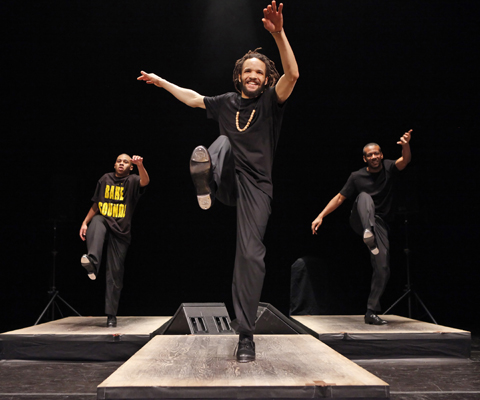
EDUTAINER Glover and crew. |
From his Broadway debut in The Tap Dance Kid at the age of 12 to winning a Tony for his choreography for Bring In ’Da Noise, Bring In ’Da Funk when he was 23, Savion Glover, now 40, has been credited with bringing renewed recognition and appreciation to tap dance.
Glover started tap lessons when he was seven, traveling weekly from Newark to New York City with his mother and his older brothers, but it wasn’t until he met some of the old-time hoofers, such as Lon Chaney, Howard “Sandman” Sims, and Jimmy Slyde, and more contemporary tappers, such as Dianne Walker and Gregory Hines, that tap really took hold of him.
“Once I got to know these men and women, it became less about the dance and more about wanting to represent them and their lives,” Glover said, in a recent phone conversation from his dance studio in Newark. “I’m dedicated to it because of them.”
He starred with Hines in the 1989 film Tap, along with Sammy Davis Jr., and with Hines on Broadway in the 1992 Tony-Award-winning Jelly’s Last Jam, as the young Jelly Roll Morton. But it was his 1996 collaboration with George C. Wolfe on Noise/Funk, a history of African Americans in this country and how the rhythms in their hearts and feet helped them survive, that brought Glover to wider acclaim.
“Tap dance has been around since air,” Glover reflected, “and I want to bring more awareness and seriousness to the art form. Some of us are still stagnated with the early images of tap dance, and because it came from such a derogatory state, we have these images in our minds. I will continue to tell about my journey and involvement and to educate audiences about what it can be. But the style I do is still on the road to gaining the proper recognition.”
Indeed, Glover has never stuck to the familiar shuffle-ball-change routine. He’s always been able to hear much more than the metal taps on the soles of his shoes; he listens for the thud off the side of his foot, the crisp ring of a quick jump onto his toe tips, the hard stomp of his full weight on one foot or the other. He’s performed with jazz groups as a captivating percussion musician, with the stage carefully miked for the sounds of his feet.
“For me — only for myself — it’s my voice, my true expression,” Glover emphasized. “I think that dance, like music, like vibrations — causes us to react. We all have a certain reaction when we hear a fire engine or when we hear a baby cry. I am hoping to reach a level in my dance where I am able to connect with people deeper than what’s on the surface — not just entertainment but edutainment.
“The approach will allow people to share in the happiness or the sadness of what’s going on,” he continued. “There’s another level, more than the visual, much more about the sound. My approach is more like a musician or like a speaker giving some type of auditory display. I feel I have much to say or a lot of music to play in order to let people understand how I feel in that moment.”